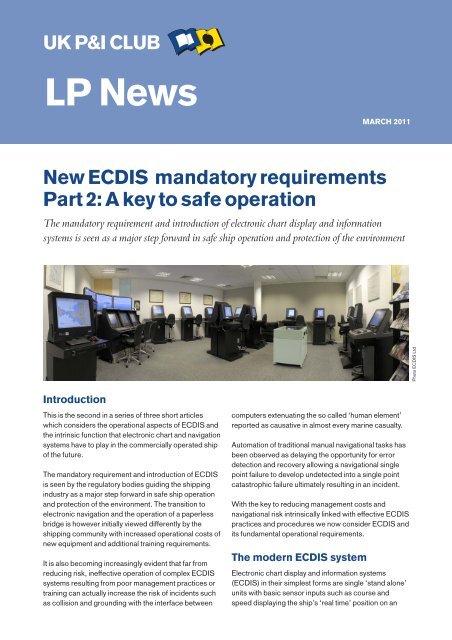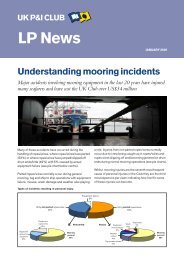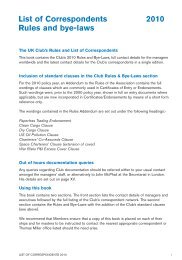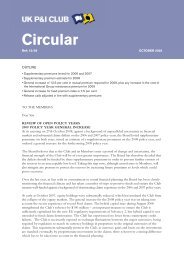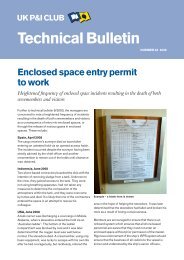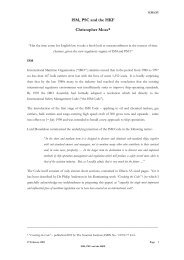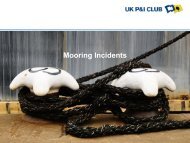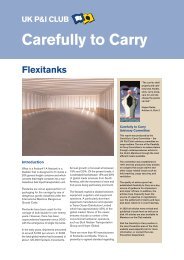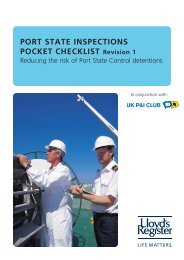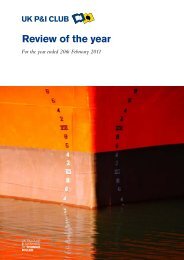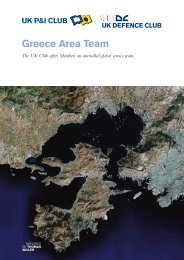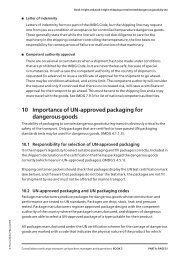ECDIS part 2 - UK P&I
ECDIS part 2 - UK P&I
ECDIS part 2 - UK P&I
You also want an ePaper? Increase the reach of your titles
YUMPU automatically turns print PDFs into web optimized ePapers that Google loves.
<strong>UK</strong> P&I CLUB<br />
LP News<br />
MARCH 2011<br />
New <strong>ECDIS</strong> mandatory requirements<br />
Part 2: A key to safe operation<br />
The mandatory requirement and introduction of electronic chart display and information<br />
systems is seen as a major step forward in safe ship operation and protection of the environment<br />
<br />
<br />
Photo <strong>ECDIS</strong> Ltd<br />
Introduction<br />
This is the second in a series of three short articles<br />
which considers the operational aspects of <strong>ECDIS</strong> and<br />
the intrinsic function that electronic chart and navigation<br />
systems have to play in the commercially operated ship<br />
of the future.<br />
The mandatory requirement and introduction of <strong>ECDIS</strong><br />
is seen by the regulatory bodies guiding the shipping<br />
industry as a major step forward in safe ship operation<br />
and protection of the environment. The transition to<br />
electronic navigation and the operation of a paperless<br />
bridge is however initially viewed differently by the<br />
shipping community with increased operational costs of<br />
new equipment and additional training requirements.<br />
It is also becoming increasingly evident that far from<br />
reducing risk, ineffective operation of complex <strong>ECDIS</strong><br />
systems resulting from poor management practices or<br />
training can actually increase the risk of incidents such<br />
as collision and grounding with the interface between<br />
computers extenuating the so called ‘human element’<br />
reported as causative in almost every marine casualty.<br />
Automation of traditional manual navigational tasks has<br />
been observed as delaying the opportunity for error<br />
detection and recovery allowing a navigational single<br />
point failure to develop undetected into a single point<br />
catastrophic failure ultimately resulting in an incident.<br />
With the key to reducing management costs and<br />
navigational risk intrinsically linked with effective <strong>ECDIS</strong><br />
practices and procedures we now consider <strong>ECDIS</strong> and<br />
its fundamental operational requirements.<br />
The modern <strong>ECDIS</strong> system<br />
Electronic chart display and information systems<br />
(<strong>ECDIS</strong>) in their simplest forms are single ‘stand alone’<br />
units with basic sensor inputs such as course and<br />
speed displaying the ship’s ‘real time’ position on an
electronic navigational chart (ENC) that complies with<br />
the performance standards outlined under the<br />
provisions of IMO Resolution A.817(19).<br />
The ENC chart must further comply with the IHO chart<br />
data transfer standard S-57 (S-100 in the future) issued<br />
by an authorized hydrographic office. The system must<br />
have an adequate back up arrangement comprising of a<br />
second independent <strong>ECDIS</strong> or an adequate up to date<br />
folio of paper charts before the system can be<br />
considered as meeting the SOLAS Chapter V<br />
Regulation 19 chart carriage requirements.<br />
Although the basic <strong>ECDIS</strong> system may be the<br />
equipment introduced during the ‘retro fit’ period for<br />
vessels presently in operation, the ship of the future will<br />
undoubtedly incorporate the electronic chart display<br />
and information system into the heart of the integrated<br />
bridge system (IBS) combining navigational equipment<br />
such as radar, differential global positioning systems,<br />
automated information systems, propulsion control and<br />
system alarms into a single monitoring station or<br />
navigation control module.<br />
Although this combination of navigational systems into<br />
a single control panel is undoubtedly the way forward,<br />
the change in navigational methodology does present<br />
new challenges in relation to the requirements of safe<br />
navigation of the modern vessel.<br />
Electronic charts<br />
The subject of electronic charts in relation to <strong>ECDIS</strong><br />
operation is probably an area which generates an<br />
element of confusion. This is primarily due to the fact<br />
that <strong>ECDIS</strong> can operate under the amendments to the<br />
IMO <strong>ECDIS</strong> performance standards in what is referred<br />
to as RCDS (raster chart display systems) mode<br />
utilizing raster charts when vector chart coverage of the<br />
navigational area is not available. In order to fully<br />
analyze this provision and mode of operation a clear<br />
distinction between raster and vector charts must be<br />
made.<br />
ENCs or vector charts are compiled from a database of<br />
individual items (objects) of digitized chart data and<br />
displayed as a seamless chart. When used in an<br />
electronic navigation system, the data can then be reassembled<br />
to display either the entire chart image or a<br />
user selected combination of data. ENCs are intelligent<br />
in that systems using them can be programmed to give<br />
warning of impending danger in relation to the vessel’s<br />
position and movement.<br />
RNCs or raster charts on the other hand are produced<br />
by digitally scanning a paper chart image. The resulting<br />
digital file may then be displayed in an electronic<br />
navigation system where the vessels position can be<br />
shown.<br />
Since the raster chart display is merely a digital<br />
photocopy of the original paper chart, the image has no<br />
intelligence and other than visually, cannot be<br />
interrogated. The fundamental differences between<br />
vector and raster charts are identified below:<br />
% Vector charts have no defined boundaries and<br />
provide a seamless visual display where raster<br />
charts operate similar to paper charts.<br />
% Raster chart data cannot itself trigger automatic<br />
alarms although some alarms may be entered<br />
manual by the user.<br />
% Horizontal datum and chart projection may differ<br />
between raster charts.<br />
% Chart features cannot be simplified or removed to<br />
suit <strong>part</strong>icular navigational circumstances.<br />
% Without selecting different scale charts the ‘look<br />
ahead’ capability of raster charts may be somewhat<br />
restricted.<br />
% Orientation of the raster display to other than chart<br />
up display may affect the readability of the chart.<br />
% Display of a ship specific safety contour or safety<br />
depth cannot be highlighted on a raster chart unless<br />
manually entered by the user during passage<br />
planning.<br />
% Excessive zooming in or out from the natural scale of<br />
the raster chart can seriously degrade capability.<br />
Under the present IMO legislation, navigational areas<br />
not covered by ENC charts must be identified at the<br />
planning stage with an ‘appropriate’ portfolio of up-todate<br />
paper charts available onboard to be used in<br />
conjunction with the <strong>ECDIS</strong> equipment when operated<br />
in RCDS mode.<br />
Although the wording ‘appropriate’ used under the<br />
provisions of the IMO Resolution has been defined<br />
differently by the various authorities of sovereign states,<br />
specific guidance can be now be found on the IHO<br />
website www.iho-ohi.net/english/encs-ecdis/encavailable/backup-paper-charts.html.<br />
With only a brief review of the requirements of<br />
electronic charts and their mode of operation in<br />
conjunction with <strong>ECDIS</strong> systems it is apparent that this<br />
is an area which requires careful review by competent<br />
well trained and familiarised officers at all stages of the<br />
navigational passage.<br />
Generic training<br />
Effective training and familiarisation of the master and<br />
officers in relation to <strong>ECDIS</strong> operation has been<br />
identified by the International Maritime Organization
Photo CSMART<br />
(IMO) as an area of increased concern prompting a<br />
revision of the training requirements at the STCW 95<br />
conference held in Manila on 21 June 2010.<br />
Under the revised STCW 95 training requirements<br />
entering into force on 1 January 2012 under the tacit<br />
acceptance procedure, the Master and those in charge<br />
of a navigational watch are required to complete a<br />
generic <strong>ECDIS</strong> training course which meets the new<br />
standards laid down under the Manila amendments.<br />
This requirement pertains to all vessels fitted with<br />
<strong>ECDIS</strong> equipment irrespective of the fact that the<br />
primary form of navigation identified under the<br />
provisions of the company management system may be<br />
paper.<br />
In the <strong>UK</strong> the present situation has recently been<br />
clarified to some extent by Marine Information Notice<br />
(MIN) 405 entitled “Training for <strong>ECDIS</strong> as Primary<br />
Means of Navigation” which was published January<br />
2011.The notice clarifies what training is acceptable for<br />
masters and deck officers of <strong>UK</strong>-flagged vessels which<br />
have <strong>ECDIS</strong> as their primary means of navigation.<br />
MIN 405 presently does not however make any<br />
reference to training requirements for vessels fitted with<br />
<strong>ECDIS</strong> systems identified under the company<br />
operating procedures to be used as an ‘aid to<br />
navigation only’ with paper charts still identified as the<br />
primary means of navigation. As MIN 405 expires on 31<br />
December 2011 it is assumed that a further instruction<br />
will be issued reflecting the Manila amendments prior to<br />
the 1 January 2012.<br />
Type specific training<br />
In general terms the requirement for type specific<br />
training for <strong>ECDIS</strong> has been identified under Section 6<br />
of the ISM Code which establishes a clear requirement<br />
for not only effective training but familiarisation with<br />
respect to safety and emergency related duties.<br />
In addition to the ISM Code requirements, Marine<br />
Information Notice (MIN) 405 paragraph 3 now identifies<br />
a clear requirement for ship specific <strong>ECDIS</strong> training<br />
relating to the make and model of the equipment fitted on<br />
the ship on which the master or navigation officer is<br />
expected to operate. Marine Information Notice 405<br />
further clarifies that this training should build on the MCA<br />
approved generic training format and be delivered by the<br />
manufacturer; the manufacturer’s approved agent or a<br />
trainer who has attended such a programme.<br />
The present requirement relating to type specific training<br />
for <strong>UK</strong>-flagged vessel is now <strong>part</strong>ially clarified under the<br />
provisions of MIN 405. The use of the words ‘and be<br />
delivered’ does however suggest that the present<br />
solution adopted by many leading manufacturers<br />
providing computer based training programs may not on<br />
their own merits be considered suitable under the new<br />
guidelines.<br />
With the dilemma relating to type specific training now<br />
clearly identified, many shipping operators may be<br />
faced with the logistical headache of either training all<br />
their operational staff in every <strong>ECDIS</strong> system within the<br />
fleet or be required to provide an onboard certified<br />
‘trainer’ having previously completed a suitable ‘train the<br />
trainer’ course.<br />
With many shipping operators encountering difficulties<br />
finding a solution to their type specific training<br />
requirements two alternatives have been identified<br />
below;<br />
At the centre for training excellence at CSMART<br />
Almeria, Amsterdam (www.csmartalmere.com)<br />
developed in conjunction with a market leading cruise<br />
ship operator, <strong>ECDIS</strong> equipment has been<br />
standardised throughout the fleet with the bridge layout<br />
replicated at the training centre. This standardisation<br />
effectively circumventing the additional requirement for<br />
type specific training as all the systems operated within<br />
the fleet is the same.<br />
This training has been further advanced by the<br />
introduction of a revolutionary bridge team management<br />
approach moving away from the traditional rank<br />
structure adopting a function based airline style<br />
‘navigator / co-navigator’ system which has been proven<br />
to effectively reduce the risk of navigational hazards.<br />
An alternative solution to the issue of the training<br />
requirements of a multi functional and diverse shipping<br />
organisation operating many different <strong>ECDIS</strong> systems of<br />
various generations has been developed by <strong>ECDIS</strong> Ltd<br />
Southampton (www.ecdis.org) .<br />
Focusing on the needs of the modern ship manager and<br />
their respective requirements, <strong>ECDIS</strong> Ltd has
developed a centre of learning excellence providing<br />
generic training course utilising many different types of<br />
<strong>ECDIS</strong> system in a single training location. This<br />
provides increased system knowledge of <strong>ECDIS</strong><br />
system operation, as well as complying with <strong>UK</strong><br />
regulations and issuing MCA / STCW <strong>ECDIS</strong><br />
certification.<br />
Passage planning<br />
Effective passage planning completed by paper chart<br />
or by electronic systems is essentially the process of<br />
defining the safest navigational route in conjunction<br />
with established safety margins under which the voyage<br />
will be executed.<br />
The passage plan should be comprehensive, detailed<br />
and easy to interpret and effectively reduce navigational<br />
risks and aid the ship and its officers to safely navigating<br />
from berth to berth. Electronic navigational planning<br />
consists of three stages namely Appraisal, Planning<br />
and Control. Although this section does not attempt to<br />
offer a guide to electronic planning the key elements will<br />
be discussed.<br />
During the cuts, the planning officer will move through a<br />
quality control process from a general plan to the<br />
refined final track which will be used for navigation and<br />
approved by the master.<br />
It is essential that the built in automatic check function is<br />
used throughout the planning stages however it must<br />
be remembered that the effectiveness of the automatic<br />
check system relies on the accuracy of the safety<br />
parameters set by the user.<br />
The final track is then often displayed with associated<br />
waypoint information and navigational notes at the<br />
central conning station or chart table for reference by<br />
the navigational officer during the Control stage of the<br />
passage planning process.<br />
Safety Safety contour contour<br />
Guard sector moves<br />
along with the ship and<br />
its direction is always the<br />
same as the ship’s<br />
direction of movement<br />
(the guard sector is not<br />
displayed on the screen)<br />
Ahead sector width, set in<br />
the Char t Alarms menu<br />
Appraisal – This stage of the plan should identify that<br />
the required electronic charts are available and<br />
corrected up to date. Areas where <strong>ECDIS</strong> would be<br />
operated in RCDS mode should be identified with<br />
appropriate paper charts available. The requirements of<br />
sovereign states during periods of coastal passage<br />
must be considered (IHO Website) with all relevant<br />
publications and sailing directions reviewed. Safety<br />
contours should be established and information relating<br />
to weather, current, tides, chart datum, draft, speed,<br />
environmental limits, air draft, squat and general<br />
hazards such as high traffic concentrations should be<br />
prepared and made available.<br />
The concept of safety contours is a key function<br />
specific to electronic charts and further outlined in the<br />
diagram below.<br />
Display<br />
Chart zero<br />
Shallow contour<br />
Blue Light blue Grey-white White<br />
Non-navigable area<br />
Safety contour (input value)<br />
Safety contour (value existing in the<br />
vector chart)<br />
Navigable area<br />
Safety depth<br />
Deep contour<br />
Planning– After the appraisal stage, the planning<br />
officer now begins the track planning. The planning<br />
stage can be divided into three different sub-stages or<br />
‘cuts’.<br />
Ship’s position<br />
when the<br />
SAFETY CONTOUR<br />
alarm occurs<br />
Control – The control stage of the plan establishes<br />
how the vessel’s progress and the navigational systems<br />
will be monitored throughout the passage. This will<br />
include an effective analysis identifying all risks of<br />
operation. When official ENC (vector charts) are used,<br />
systems of automatic and manual checks must be<br />
established if the danger of over reliance on automated<br />
systems is to be avoided.<br />
Traditional track monitoring methods such as parallel<br />
index and visual bearings should be included at the<br />
control stage in addition to modern techniques such as<br />
radar overlay of the electronic chart. This should<br />
however not obscure the radar picture to the level<br />
where acquired targets may be lost or the navigation<br />
officer may be affected by information overload.<br />
Risk analysis<br />
Length was input in the<br />
Safety Contour frame in<br />
the Alarm Settings ><br />
Chart Alarms menu<br />
On review of the increased technology available to the<br />
modern navigator one of the conundrums must be why<br />
increased computerisation and automation has not<br />
removed, and perhaps not even reduced the potential<br />
for failure in the systems in which they were introduced.<br />
In fact new pathways to failure seem to have developed<br />
centered on an initial miscommunication between man<br />
and machinery resulting in a misalignment in the reality
of where the navigator thinks he is and where the<br />
automated system has actually taken him.<br />
Research has shown that humans are poor monitors of<br />
automated systems and tend to rely more on system<br />
alarms than manual checks especially in relation to<br />
those systems which have proven themselves as highly<br />
reliable.<br />
In several casualty investigations it has been<br />
determined that automation has resulted in the<br />
navigator developing an ‘operational bias’ relying on the<br />
automated systems rather than the salient cues<br />
provided visually through the bridge window.<br />
In this respect an extensive risk assessment of <strong>ECDIS</strong><br />
operation combined with a clear requirement of manual<br />
system checks of critical automated operations must be<br />
established within the company Safety Management<br />
System effectively identifying operational risk and<br />
introducing control measures to reduce the effect of<br />
single point failures.<br />
Before we consider the assessment process, the term<br />
risk must be defined. Risk in relation to <strong>ECDIS</strong><br />
operation can be considered as a hazard or source of<br />
navigational error with the potential to cause loss or<br />
harm to personnel, the environment or the ship (or other<br />
ships) itself.<br />
The main areas of risk when considering <strong>ECDIS</strong><br />
operation can be identified under three main<br />
categories:<br />
1. The equipment itself may suffer from failure (both<br />
hardware and software) including power outages<br />
sensor input failure and potential virus infection.<br />
Effective risk assessment as a critical function of<br />
implementation of electronic navigation is rarely<br />
emphasised when the transfer from paper to digital<br />
navigation is considered.<br />
As our short review of this subject has hopefully<br />
highlighted a full and comprehensive risk assessment<br />
clearly identifying the hazards relating to the operation<br />
of <strong>ECDIS</strong> systems should not only assist those<br />
associated with the task of transfer between the two<br />
methods of navigation but also accelerated the<br />
migration process and the positive aspects of<br />
electronic chart operation relating to increased crew<br />
efficiency whilst reducing operational costs.<br />
Conclusion<br />
From this short review of <strong>ECDIS</strong> operation and the<br />
functions to consider when transferring navigational<br />
practices from paper to electronic format, it is clear that<br />
the process, although complex, can if effectively<br />
completed, reduce operational cost whilst increasing<br />
levels of safety.<br />
The effect of poor management and training in relation<br />
to <strong>ECDIS</strong> operation can however result in increased<br />
navigational risk and operational costs including<br />
detention during port state inspections and increased<br />
navigational related incidents.<br />
In conclusion of our review of <strong>ECDIS</strong>, the third and final<br />
in this series of short articles considers the legal<br />
implications of inefficient <strong>ECDIS</strong> operation and the<br />
effect increased playback and recording facilities of<br />
modern bridge equipment may have on the casualty<br />
investigation and claims handling process.<br />
2. The charts are operated under permit which may<br />
expire, charts in use not corrected up-to-date,<br />
updates not correctly applied, ENC chart coverage<br />
unavailable requiring the system to be used in<br />
RCDS mode without the appropriate paper chart<br />
folio being available.<br />
3. The operation of the <strong>ECDIS</strong> system onboard<br />
carried out by poorly trained crew following poor<br />
navigational practices and operational procedures<br />
such as excessive zooming or operating the chart for<br />
navigation with base information only displayed.<br />
Acknowledgement: Justin Lawes, C Solutions Limited.<br />
Email: justin@csolutionslimited.com<br />
<strong>UK</strong> P&I CLUB<br />
IS MANAGED<br />
BY THOMAS<br />
MILLER<br />
For further information please contact:<br />
Loss Prevention De<strong>part</strong>ment, Thomas Miller P&I Ltd<br />
Tel: +44 20 7204 2307. Fax +44 20 7283 6517<br />
Email: lossprevention.ukclub@thomasmiller.com


